Training for long-distance cycling randonneur events on the ElliptiGO is actually very similar to the training regimes we recommend for events of about 100-miles distance. It’s not as time-demanding as some people may initially think and will require regular riding 3-5 times per week, with a few longer practice rides/events from time to time during the training build-up.
With regard to time-commitments, training for cycling events of 200km and beyond, on the ElliptiGO, is no more demanding than training for a (cycling) century – and possibly less demanding (in relation to training hours) than an Ironman Triathlon.
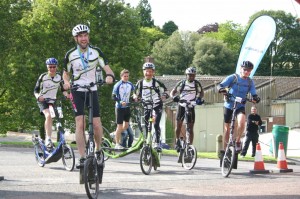
We have used training regimes involving 3 rides a week, as well as training regimes involving 5 rides a week – so we can design your bespoke programme based on your time availability and training preferences. Mixing the schedule with running or cycling (on a road bike) will be a bonus, but is not essential for this training challenge.

If you are keen on joining The ElliptiGO Ultra-Endurance Team, but you also want to train for other endurance sports at the same time, we can integrate your ElliptiGO training into your schedule in a way that actually supports your other sporting goals (such as running – or cycling on bikes other than the ElliptiGO). ElliptiGO cross-training is perfect for boosting running and conventional cycling fitness and it can integrate well with sporting goals in those (and many other) sports.
Case Studies:
Riders in the ElliptiGO Ultra-Endurance Team have come from a wide variety of backgrounds and the sample training plans (below) give a good insight into how some of our most successful athletes prepare themselves for long-distance cycling events on the ElliptiGO.
Case Study 1 – Penny Fogel:

One of our PBP 2015 Team riders had a very notable journey. Penny, a single Mum in her early 50’s, was a “general fitness enthusiast” and didn’t have a big endurance sporting background. In fact, she’d never even trained on an ElliptiGO before declaring her interest in joining The Team!
She bought herself an 8 speed ElliptiGO 8S and went on to ride Audax event distances ranging from 200km-400km within just 4 months of starting her training. Penny also completed two (unverified) 600km rides in a 2 week period in June 2015 – just 6-months after her first ElliptiGO training session! If that isn’t audacious – nothing is!
Case Study 2 – Andy Nuttall:
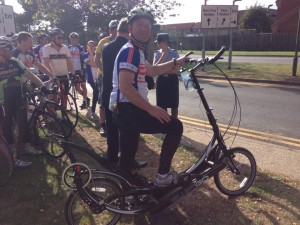
Andy initially bought an 8-speed ElliptiGO 8C in mid-2014, to help improve his fitness and lose weight. He had been very ‘sporty’ in his yournger days but had then become inactive and was obese in his early 40s. He actually threw up and almost passed out after his first ElliptiGO ride (a 20-minute session at a test ride with his local ElliptiGO dealer).
But he still bought himself an 11-speed ElliptiGO 11R in September 2014 and within just 3-months he’d declared his intention to join The ElliptiGO Ultra-Endurance Team to train for Paris Brest Paris (PBP 2015), a 1,200km Audax event with a 90-hour time-limit. Andy completed his first 200km ElliptiGO ride in the first week of January 2015 – after just 4 months of ElliptiGO training.
He then went on to complete a full Audax Super Randonneur Series (200km, 300km, 400km & 600km Audax rides) on his ElliptiGO to qualify to ride in the PBP 2015 event and has since gone on to ride in many more ultra-distance cycling events on his ElliptiGO Arc and 11R bikes. Andy’s training plan for his Super Randonneur series is outlined in the listing of sample training plans (below):
Case Study 3 – Tim Woodier:
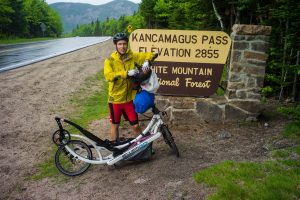
Tim was initially a ‘doubter’ when it came to the benefits of stand-up biking, but a niggling foot injury during his training for an 80-mile ultra-marathon running event had ‘forced’ him to capitulate and he eventually bought himself an 8-speed ElliptiGO bike (at the end of November 2015).
Tim’s natural talent on the ElliptiGO was spotted almost immediately (after Idai had observed his early initial training rides in the Welsh hills, on the ElliptiGO Strava training Group). Idai had invited Tim to take on a 200km Audax cycling event on his new ElliptiGO on 2 January 2016 – just a month after Tim had acquired the bike! Tim performed flawlessly in his first ever cycling event – completing the 200km ride with ease.
Tim then went on to complete a full Audax Super Randonneur Series (200km, 300km, 400km & 600km Audax rides) on his ElliptiGO, by May 2016. In June 2016 Tim had then embarked on the most gruelling bike tour ever completed on an ElliptiGO (riding a total of 6,800-miles, across a 3-month period, on a trip to vist ElliptiGO riders in and around the Eastern USA). Tim’s training plan for his Super Randonneur series (and the 6,800-mile ElliptiGO tour) is outlined in the listing of sample training plans (below):
Case Study 4 -Simon Devereux:
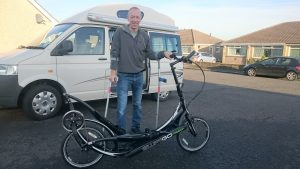
Simon took up ElliptiGO training in January 2017 – just weeks after undergoing double hip replacement surgery. He started his ElliptiGO long-distance cycling quest with just 5-minutes of training per day, using an indoor trainer.
But within four months he was able to complete a 50-mile training ride. And just 10-months after his hip replacement surgery Simon successfully completed a 200km Audax ride, within the stipulated time-limits!
Like the other riders profiled above, Simon has shown that it does not take long to reach peak condition using an ElliptiGO. The key ingredients for success in long-distance cycling are accountability, audacity, commitment and focus….
Below are examples of training programmes used by our founding team athletes (who have ridden successfully in a number of Audax cycling events up to 1,400-km long, and beyond, on ElliptiGO bikes) and also some preparation tips for team riders to consider (based on feedback from previous team training discussions):
Alan’s Training Programme:
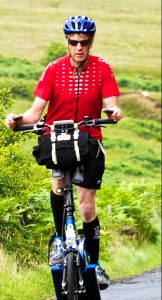
LEL 2013 (London-Edinburgh-London) was my first multi-day ElliptiGO event and my preparation was based on long, easy-effort ElliptiGO rides. Below is my training plan:
Sun: Long, easy-effort ElliptiGO ride.
Mon: Rest.
Tues/Wed/Thurs: Short (1-2 hour), medium intensity session of either running, cycling, ElliptiGO riding.
Fri: Rest.
Sat: Long, easy-effort ElliptiGO ride.
Over six months, I gradually built up the weekend mileage (from about 60-miles, to 400-miles).
Training objectives:
1) Establish a level of riding effort that I could sustain for long periods of time.
2) Develop a nutrition strategy that would provide the fuel for objective 1.
3) Mental preparation.
Andy’s Training Programme:
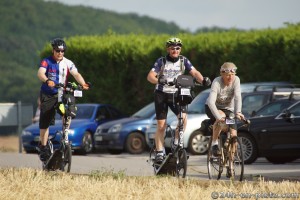
Sunday: Evening Gym Session (1.5 Hrs). Cardio Workout (Eliptical/Runing Machine) then Kettle Weights and Free Weights. With an ad-hoc 10 mile / half marathon run whenever an event I want to do is in the callendar.
Monday: High intensity ElliptiGO work commute (26-miles total).
Tuesday: Evening Gym Session (1.5 Hrs). Cardio Workout then Kettle Weights and Free Weights.
Wednesday: High intensity ElliptiGO work commute (26-miles total).
Thursday: Evening Gym Session (1.5 Hrs). Cardio Workout then Kettle Weights and Free Weights.
Friday: High intensity ElliptiGO work commute (26-miles total).
Saturday: Morning 5K Parkrun, Afternoon Swim session.
This is how I am training for the London – Edinburgh – London in July 2017, amongst other challenges. In September of 2016 I decided to complement my ElliptiGO Training by running the Saturday Morning Parkruns, whilst my two children played hockey.
Also, as the weather here in the UK can be rather cold, wet and dark on the daily commute in Winter, I changed my Cardio Workout to the more pleasent surrounding of the local Gym.
Andy’s Training objectives:
1) Improve my overall stamina for long-distance EllipiGO Events.
2) Develop a nutritional strategy that would provide the fuel for objective 1.
3) Become an all-round, healthy athelete.
Billy’s Training Programme:
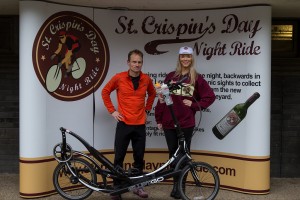
How I train:
This is a sample training week (6-12 April 2015) during qualification for the 1,200km Paris Brest Paris Audax. I did my 200km qualifying ride on 29 March 2015 and my 300km qualifying ride on 18 March 2015, so this was the training week between the two Audax events and represented a really tough week sandwiched between two easy weeks.
*HR = Heart Rate. *Avg = average. *Ascent = cumulative ascent for session.
Monday (Easter Monday – not working): ElliptiGO hill ride (3 Hours), 55.1km at Avg speed 18.33kph, Avg HR 114bpm, Max HR 150bpm, Ascent 913m – followed immediately by one hour on the ElliptiGO indoor trainer (Avg HR 93bpm). So a total of 4 hours, training fasted (zero-calories).
Tuesday: Gym – weights – legs, ElliptiGO home easy, 7km at 21.2 kph, Avg HR 110bpm, Max HR 134bpm, Ascent 38m, Versaclimber 10 mins (1,575 feet of climbing).
Wednesday: ElliptiGO ride to work – 10.7km at 25.08kph, Avg HR 125bpm Max HR 154bpm Ascent +23m, ElliptiGO ride back home – 7km at 21.2kph, Avg HR 112bpm Max HR 135bpm, Ascent + 39m.
Thursday: ElliptiGO ride to work – 10.7km at 27.6kph, Avg HR 143bpm, Ascent +17m, Pilates, ElliptiGO ride back home 6.9km at 22.5kph, Avg HR 125bpm, Max HR 147bpm, Ascent + 37m.
Friday: ElliptiGO ride to work – 10.7km at 25.2kph, Avg HR 125bpm, Max HR 145bpm, Ascent + 19m, ElliptiGO ride back home – 1hr38min, 37.6km at 22.9kph, Avg HR 123bpm, Max HR 152bpm, Ascent +241m.
Saturday: Fasted ElliptiGO ride (zero-calories), vertical Km target was to break 3h – took 2hrs 58min to cover 52.9km at 17.7kph, Avg HR 122bpm, Max HR 160bpm, Ascent +1,030m (no hills bigger than 100m in Jersey)!
Sunday: ElliptiGO fasted 100km ride (zero-calories), a mix of road and indoor riding. 76km on the road in 3hrs 18min – Avg speed 22.95kph, Avg HR 115bpm, Max HR 140bpm, Ascent +123m, followed by 60 mins on indoor trainer.
*Total of 319km (includes estimate for indoor trainer ride) in 10 sessions, includes 2,337m of ElliptiGO climbing, weights, Pilates and Versaclimber (a type of indoor stepper machine).
Carl’s Training Programme:
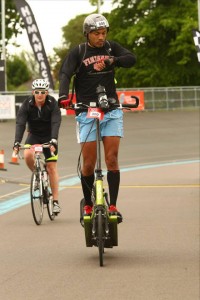
Sunday: ElliptiGO long ride (70-100 miles) or a 10-mile run (the run done on alternate weeks, instead of the long ElliptiGO ride).
Monday: ElliptiGO work commute (26-miles total).
Tuesday: Road Bike work commute (26-miles total). Also 7-Mile Run.
Wednesday: ElliptiGO work commute (26-miles total).
Thursday: Road Bike work commute (26-miles total). Running: speed-work (6 x 800m or 16 x 400m).
Friday: ElliptiGO work commute (26-miles total).
Saturday: ElliptiGO (15 x Hill Repeats).
This is how I trained for The Flatlands 600km Audax and I will be doing the same for PBP 2015. I normally vary my training in 5-week cycles (increasing my running hill reps from 10 per session to 15 per session, across the 5 week period). I use the same training plan to prepare myself to run in half marathons and will sometimes substitute my long runs with a running event and my long ElliptiGO rides with a cycling sportive event (on the ElliptiGO).
Idai’s Training Programme:
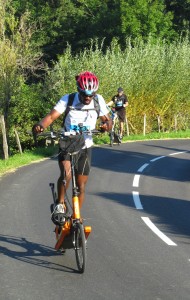
The schedule shown below was used for both LEL 2013 & PBP 2015 and relied on a relatively high training volume. I have used a wide variety of training approaches for Audax rides and in 2017 I will be relying on a lower volume approach (outlined on this page) which I used for LEJOG 2016.
Sunday – ElliptiGO Long Ride (70-miles, at moderate effort – Heart Rate Zone 2-3).
Monday – Rest.
Tuesday – Rest.
Wednesday – Medium Distance ElliptiGO Ride (30-35 miles, moderate effort – Heart Rate Zone 3).
Thursday – Gym (Kickboxing and Weight Training).
Friday – Medium Distance ElliptiGO Ride (30-35 miles hard effort – Heart Rate Zones 3, 4 & 5).
Saturday – Rest.
I don’t eat before (or during) training because I prefer to train while fasting (to build on my fat burning efficiency, to minimise my weight/body fat – and to allow me to become even stronger when I do eat during my long-distance endurance events). During training I only consume water. On training days I will eat my first meal of the day immediately after training (but I don’t eat before – or during – training). However, I normally eat hourly during actual long-distance cycling events.
When preparing for a long-distance cycling event I first increase my training volume, whilst sticking to lower-paced (easy) riding. I then start to increase my training intensity (pace) after I have reached my peak weekly training volume. Regardless of whether I use a low-volume or a high-volume approach in my training plan, the bulk of my training rides are done at a low-to-moderate intensity. I do not do a lot of high intensity sessions on the bike, but when I am at peak fitness I can produce reasonable pace at lower effort levels. I also stretch 3-4 times a week, to maintain my flexibility and to prevent injuries.
Stuart’s Training Programme:
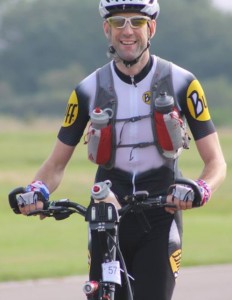
My training schedule for next year (for my 100-mile ultra-marathon run and the PBP 2015 ElliptiGO ride) is outlined below:
This is pretty much how I trained for The Western States 100-mile Trail Run and the UTMB (Mt Blanc 100-mile Ultra Run) in 2013. It worked well, getting me into peak ultra-distance running shape and good ElliptiGO long-distance riding shape.
Sunday – REST
Monday – Tempo Run or Hills (5-8 miles).
Tuesday – Commute to work on ElliptiGO (70-miles round trip).
Wednesday – Steady Run (10-20 miles) Sometimes this is split into lunchtime and evening runs instead.
Thursday – Run: Intervals/Hills (5 miles).
Friday – REST.
Saturday – Slow Long Run (20-50 miles) OR Long ElliptiGO Ride (40-130 miles). I usually look for variation in terrain, including hills.
As part of the above training, the weekend run/ride will sometimes be replaced with an endurance event (a half marathon, marathon, or 100-125 mile ElliptiGO ride in a cycling event).
Tim’s Training Programme:
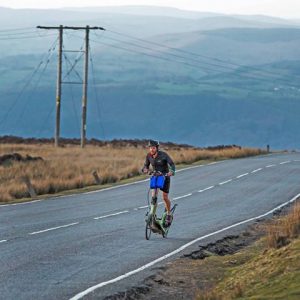
Monday: Rest.
Tuesday: 1 hour Tabata (high intensity interval) training & core workout and also an hour ElliptiGO ride (generally up “The Tumble”, a local 500m climb).
Wednesday: Run with fell running club. 6-10 miles, with around 500m elavation gain (off road).
Thursday: 1-2hr ElliptiGO ride, then 1hr masters swim interval session at local leisure centre.
Friday: Tabata and core workout (1Hr) and another hilly 1-hour ElliptGO ride.
Saturday: Long ElliptiGO ride, perhaps an Audax cycling event, or a 100-200km ride with lots of hill climbs.
Sunday: One hour ElliptiGO ride, usually up a long hill.
The schedule is very dependant on my work schedule for the week – and also on the weather. Because I am self-employed (and work varying hours) I often have the luxury of doing the long rides on the best weather days and can move things about in my training plan, to suit my work and family schedules. Also, any of the shorter rides (up to 2hrs – I cant hack any longer) might be done on my indoor elliptical machine (due to bad weather, darkness, or childcare duties).
PBP 2015 Team Training Tips & Feedback:
Here are some useful preparation and training articles from our PBP 2015 Team campaign:
- 14 Nov 14: Mental Training and Visualisation for Ultra-Endurance Events.
- 15 Nov 14: Tackling Sleep Deprivation in Ultra-Endurance Events.
- 18 Nov 14: Building Your Long-Distance Cycling Mileage.
- 28 Nov 14: The Highs and Lows of the Ultra-Endurance Diet.
- 20 Dec 14: Exploring the Great Indoors (Indoor Training for PBP 2015).
- 27 Jan 15: Follow Your Heart (Monitoring Your Heart Rate for PBP 2015 Training).
- 29 Jan 15: ElliptiGO Long Distance Riding Technique (Comfort and Efficiency).
- 1 March 15: 115-mile Training Ride Video (More Tips for Heart Rate Monitoring).
- 14 March 15: Century-Distance (200km) Training Ride Report (By Stuart Blofeld).
- 28 March 15: 300km Team Ride Report (By Stuart Blofeld).
- 11 April 15: 300km Ride Report (By Stuart Blofeld).
Outcomes: Full PBP 2015 Team Results & News Reports.
2017 Training Tips & Feedback:
- 20 January 2017: Tips for Dealing with Cold Hands & Feet during long rides.
- 8 April 2017: What to Carry on a Long Audax Ride.
- 22 May 2017: Nutrition – The Most Important Aspect of Riding Long Distances
- 28 September 2017: Intermittent Fasting for Endurance Athletes
Outcomes: Full 2017 Ultra-Endurance Team Results & News Reports.
More training-related articles can be found on this link and further motivation can be found on this link.
